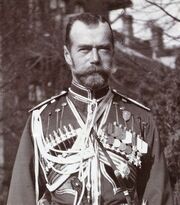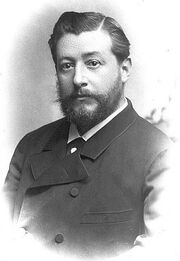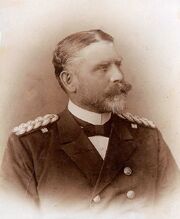
Nicholas Alexanandrovich Romanov (1868 - ?) was a member of the Romanov family who reigned as Tsar Nicholas II of the Russian Empire for twelve years. He succeeded to the Imperial throne at the age of 20 in October 1888.
Early Life and Elevation
Nicholas was born in St. Petersburg on 18 May 1868, during the reign of his grandfather Tsar Alexander II. Nicholas became the heir to the Russian throne in 1881 following the assassination of Alexander II and the accession of his father Alexander III. Seven years later in October 1888 Nicholas suddenly found himself elevated to the throne himself after his father's death in a train wreck.
The 1880s had been a turbulent period of rebellion and anarchy called the Bloody Eighties elsewhere in Europe, but the presence of loyal troops in St. Petersburg had kept the troubles from spreading to Russia. The death of Alexander III was the signal for uprisings in St. Petersburg and Moscow. Nicholas became convinced that the uprisings were the work of French radicals who had entered the country secretly and were being protected by Russian radicals. He ordered the Russian secret police, the Okhrana, and the army to put down the uprisings and eliminate all potential subversives throughout the country. Over the next five years, over two million people had been killed, and another 80,000 suspected subversives were imprisoned in camps on the Kamchatka peninsula.
Alaska Gold Strike

In 1894 Nicholas's foreign minister, Prince Pyotr Sviatopolk-Mirsky, was approached by Diego Cortez y Catalán, the President of the Mexican company Kramer Associates. Cortez's mineralogical experts had informed him that there were large copper deposits to be found in the Yukon region of Russian Alaska, and he sought to gain a copper concession for his company there. Cortez was granted his concession, under the terms of which K.A. would pay all the costs of locating and refining copper deposits, and any profits would be divided evenly with the Russian government. The Russian government would have the final say over the acceptability of K.A. employees engaged in copper production, and any mining camps established would be under the political control of Russian officials.
K.A. prospecting teams entered the Yukon region in the spring of 1895, and for over a year found little of value. However, in July 1896, a team led by Winston Carew struck a vein of gold. By the end of the year, Carew reported back to Cortez that "the nature and full extent of the fields cannot be determined. But there is no doubt that this is the most important gold discovery in the history of mankind." Even allowing for exaggeration on Carew's part, the Yukon gold fields were the most valuable property K.A. possessed.
Word of the gold strike came at a critical time in St. Petersburg. The Russian government had borrowed heavily in order to finance a major railroad construction program, and Finance Minister Serge Witte had despaired of being able to meet the interest payments on the loans. Now, however, the Russian government's financial worries were over. Nicholas wired his personal congratulations to Cortez and Carew, wishing them "continued good fortune in our joint enterprise."
War with Mexico

Within a year, the prospect of controlling the world's largest gold fields proved too hard for the Russian government to resist. On 21 October 1897 Sviatopolk-Mirsky issued a memorandum claiming that the agreement with K.A. had covered only copper discoveries, and that any gold mines established in Alaska would be the sole property of the Russian government. Sviatopolk-Mirsky ended the memorandum with a suggestion that K.A. would be allowed to operate the mines "for which the company would, of course, be well-compensated."
Cortez was outraged when he received the telegram from Sviatopolk-Mirsky, running shouting out of his office in San Francisco. When he cooled down, Cortez telephoned Mexican Chief of State Benito Hermión and arranged for a meeting in the Presidential Palace in Mexico City on 25 October. Sobel states that nothing certain is known about what was discussed between Cortez and Hermión, but that the Chief of State did not wish to become involved in the dispute between K.A. and the Russian government.
Cortez then determined to act alone, using his influence with California Governor Alberto Puente to arrange for a series of border incidents between the California Guard and Russian forces. Cortez then arranged for a translator in the Mexican State Department to mistranslate a series of messages between Hermión and Sviatopolk-Mirsky to increase tensions between the two countries. Finally, after a major border incident in May 1898, a Russian regiment invaded California and marched on San Francisco. The Great Northern War had begun.
With Russian troops invading Mexico, Hermión acted. Units of the Mexican Pacific Fleet entered San Francisco Bay and landed 20,000 marines, which together with the California Guard put the Russian regiment to flight. Mexican soldiers pushed into Alaska while a second force of Marines landed at Nikolaevsk on 5 July. In August the main Russian army under General Mikhail Kornilov surrendered to Mexican General Richard Stockton, and by the end of October all of mainland Alaska was under Mexican control.
With the gold fields now under his control, Cortez sought to end the war. He contacted the Japanese government, requesting that they offer to mediate a peace agreement. The Japanese agreed, and on On 5 January 1899 the Japanese ambassador to Mexico, Ono Yamashita, met with Secretary of State Felicio Montoya and asked whether Hermión was prepared to set down his terms for peace. At the same time, ambassador to St. Petersburg Baron Keigo Kiyoura spoke with Sviatopolk-Mirsky about possible Japanese mediation. Sviatopolk-Mirsky suggested Tokyo as a suitable site for negotiations, but Montoya, under orders from Hermión, told Yamashira that Mexico would discuss peace only if the Russians admitted that they had violated Californian territory, would cede Alaska to Mexico, and would pay an indemnity of $2.5 million. The Russians refused Hermión's terms, and the war continued.
War in Siberia and Revolution
On 28 May 1899 a Mexican naval force began the occupation of the Aleutian Islands. While the occupation was still going on, the Pacific Fleet left Hawaii and began steaming west to Siberia. The Pacific Fleet landed a force of marines at Petropavlovsk, Kamchatka on 28 June, followed by landings at Okhotsk on 15 July and at Nikolaevsk-on-Amur on 26 July. The Russians attempted to halt the Nikolaevsk landings by engaging the Pacific Fleet at the Battle of the Okhotsk Sea on 23 July. The battle was a complete Mexican victory, with the Russians losing two battleships and fourteen other ships sunk, and the loss of 20,000 men. The Mexicans lost only nine dead and fourteen wounded when a boiler on the battleship Andrew Jackson exploded. By 10 August the three Mexican beachheads were joined, and Mexican troops had marched inland to secure all Siberian territory within 200 miles of the Pacific coast.

By early October 1899 all the major population centers up to the Kolyma River were in Mexican hands, while in the south the Mexican marines ruled the region as far inland as Kharbarevsk. The Mexicans freed the political prisoners being held in Kamchatka, and some 7,000 organized the Free Russian Brigade, which fought alongside the Mexicans and rendered invaluable assistance during the campaign. Admiral Ephraim Small was named Administrator of Siberia, establishing his headquarters at Udsk. In November, Small received permission from Hermión to organize the freed political prisoners into a "Provisional Free Russian Government", which was recognized by the U.S.M. as the legitimate authority in Siberia under Premier George Tsukansky on 23 November 1899.
The loss of the Alaska gold fields precipitated a financial crisis in St. Petersburg and a severe economic downturn aross European Russia. Banks failed and factories shut down, leaving tens of thousands of middle-class and working-class Russians destitute and starving. The result was an uprising in St. Petersburg on 2 February 1900 which quickly spread to the Empire's other European cities, the outbreak of the Russian Revolution.
The revolution was led by Count Witte, the former Finance Minister; the liberal reformer and educator Pavel Miliukov; and General Vladimir Malenkov. Although the three men had different aims for the revolution, they all agreed that the first step would have to be the abdication of Tsar Nicholas. As peripheral areas of the Empire such as Poland, the Ukraine, and the Baltic provinces broke away, Nicholas found support for his government dropping. On 17 July Nicholas abdicated in favor of his younger brother Michael II, and he left Russia for Great Britain along with most of the Imperial family. He remained there for the rest of his life.
Sources
Sobel's sources for the reign of Nicholas II are Feodor Kluchansky's Russia in Exile (London, 1911); Ferdinand Rainy's Nicholas II and the White Terror (New York, 1955); and Zoë Montgomery's The Russian Revolution (New York, 1967).
IOW Nicholas II was imprisoned in the summer of 1917 several months after his abdication, and executed along with the rest of his immediate family in July 1918.